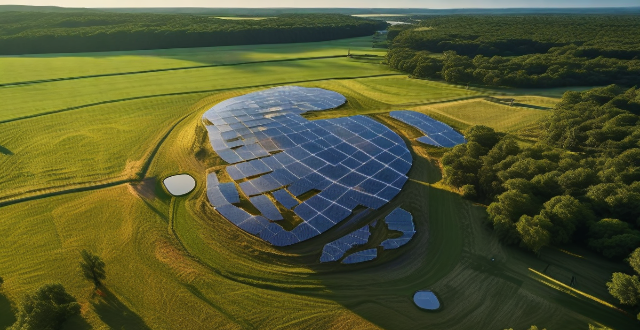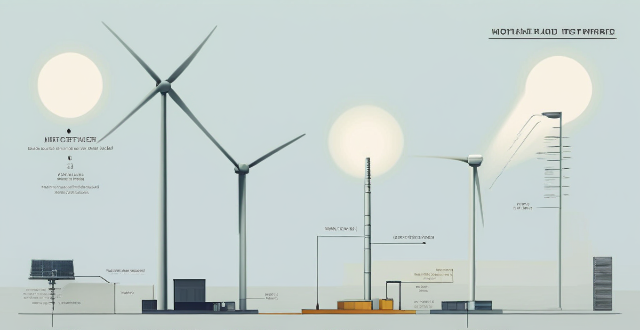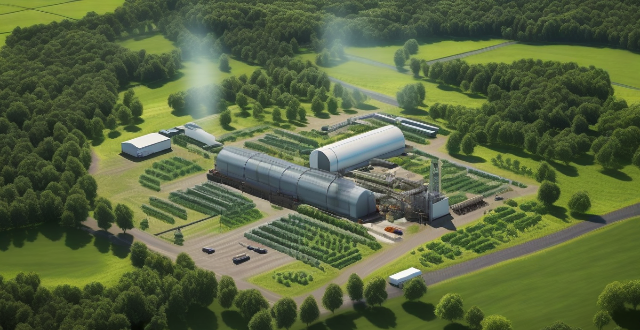Energy Tidal

How do tidal and wave energy systems generate electricity ?
Tidal and wave energy systems are renewable sources of energy that harness the power of ocean movements to generate electricity. These systems work on the principle of converting the kinetic energy present in the tides and waves into electrical energy, which can then be used for various applications. Tidal barrages create a difference in water level between two sides of a barrage, built across an estuary or bay with significant tidal range. As the tide rises, water flows through turbines located within the barrage, generating electricity. When the tide goes out, the process is reversed, with water flowing back through the turbines in the opposite direction, generating additional electricity. Tidal stream systems use underwater turbines placed in areas where tidal currents are strong. Unlike tidal barrages, tidal stream systems do not require large infrastructure and can be deployed in various locations where strong tidal currents exist. Wave Energy Converters (WECs) are devices designed to capture the energy from ocean waves and convert it into electricity. There are several types of WECs, including point absorbers, attenuators, and terminators, each working slightly differently but sharing the same goal of harnessing wave energy.

How efficient are modern tidal and wave energy conversion systems ?
Modern tidal and wave energy conversion systems aim to harness the power of oceanic movements for electricity generation. The efficiency of these systems is a critical factor in determining their viability as significant contributors to the global energy mix. Tidal energy conversion systems operate by capturing the kinetic energy from the rise and fall of tides, while wave energy conversion systems extract energy from the motion of ocean waves. Both tidal and wave energy conversion systems face similar challenges that affect their efficiency, including cost, environmental concerns, and technical hurdles. Continued research, technological advancements, and policy support will be crucial in improving their efficiency and ultimately realizing their potential as significant contributors to our clean energy future.

What are the challenges in developing and implementing tidal power as an alternative energy source ?
Tidal power is a promising alternative energy source that harnesses the energy of ocean tides to generate electricity. However, its development and implementation face several challenges, including technical, environmental, economic, and social aspects. Technical challenges involve efficiency and reliability issues with turbine design, maintenance, and power transmission. Environmental challenges include potential impacts on marine life and water quality. Economic challenges involve high upfront costs and market competitiveness. Social challenges encompass community acceptance, legal and regulatory hurdles, and local economy impacts. Addressing these multifaceted challenges is crucial for the successful development and implementation of tidal power on a larger scale.

How does Apple Music compare to other music streaming services like Spotify or Tidal ?
This text compares Apple Music, Spotify, and Tidal in terms of their user interfaces, music libraries, audio quality, pricing, and additional features. Apple Music integrates seamlessly with Apple devices and offers personalized recommendations, while Spotify emphasizes social sharing and collaboration. Tidal focuses on high-quality audio and exclusive content from artists. The choice between these services depends on personal preferences and priorities when it comes to music streaming.

What are the main sources of sustainable energy ?
The text discusses the various main sources of sustainable energy, including solar energy, wind energy, hydropower, geothermal energy, bioenergy, tidal and wave energy, and hydrogen energy. It also highlights the importance of adopting sustainable energy for environmental impact, economic benefits, energy security, and health considerations. The transition to sustainable energy requires investment, policy support, and technological innovation.

What are the most promising renewable energy technologies for reducing carbon emissions ?
Renewable energy technologies are crucial for reducing carbon emissions and combating climate change. They harness natural resources such as wind, solar, hydro, geothermal, and biomass to produce electricity or heat without emitting greenhouse gases. This article discusses the most promising renewable energy technologies for reducing carbon emissions. Solar energy can be generated through photovoltaics (PV) or concentrated solar power (CSP). Wind energy is growing rapidly due to its low cost and minimal environmental impact. Hydropower is a significant source of clean power but has environmental concerns. Geothermal energy has a high capacity factor but limited availability. Bioenergy helps reduce dependence on fossil fuels but requires careful consideration of land use changes. Wave and tidal energy have immense potential but are still in early development stages. Overall, these technologies offer unique benefits and challenges for creating a sustainable future.

What are some innovative ways to generate sustainable energy ?
The article discusses various innovative ways to generate sustainable energy. These methods include solar power, wind power, hydropower, geothermal energy, biomass energy, and wave energy, each with their unique techniques and systems.

How efficient is wind energy compared to other renewable sources ?
The efficiency of wind energy is influenced by factors such as capacity factor, technological advancements, and site specificity. Compared to other renewable sources like solar, hydropower, geothermal, biomass, and tidal/wave energy, wind energy has a relatively high capacity factor ranging from 35% to 45%. Technological improvements have increased the efficiency of wind turbines over the years, making them more productive. However, the efficiency of wind farms is highly dependent on the location, with optimal sites achieving higher efficiency rates. In conclusion, wind energy compares favorably to other renewable sources in terms of efficiency, but the choice between different renewable energies often depends on local conditions, economic factors, and technological advancements.

What are the most promising alternative energy sources for the future ?
The world is in urgent need of sustainable and renewable energy sources as it grapples with climate change and the depletion of fossil fuels. Some of the most promising alternative energy sources for the future include solar energy, wind energy, hydropower, geothermal energy, biomass energy, and tidal energy. Solar energy is abundant and renewable, with no greenhouse gas emissions during operation. It can be installed on rooftops or in large solar farms, and technological advancements have made it more efficient and affordable. However, it faces challenges such as intermittent power generation, high initial installation costs, land use concerns, and efficiency drops in colder climates. Wind energy is also renewable and abundant, with no greenhouse gas emissions during operation. It can be installed on land or offshore, and technological advancements have made it more efficient and affordable. However, it faces challenges such as intermittent power generation, noise pollution from turbines, impact on wildlife, and visual impact on landscapes. Hydropower is a reliable and renewable source of energy that can provide baseload power to the grid. It can also be combined with other renewable sources for energy storage. However, it faces challenges such as environmental impact on aquatic ecosystems, limited potential for expansion due to suitable sites being scarce, seasonal variability in water flow affecting power generation, and large upfront capital costs for construction. Geothermal energy is a reliable and renewable source of energy that can provide baseload power to the grid. It can also be used for heating and cooling purposes as well as electricity generation. However, it faces challenges such as limited to specific geographic locations with geothermal resources, environmental impacts such as water usage and land subsidence, high initial installation costs, and potential for induced seismicity in certain areas. Biomass energy is a renewable and abundant source of energy that can be used for both electricity generation and heat production. It can help reduce waste by utilizing organic materials that would otherwise be discarded and can provide jobs in rural areas through the collection and processing of biomass materials. However, it faces challenges such as emissions of greenhouse gases and air pollutants during combustion, competition with food crops for arable land and water resources, high transportation costs for biomass materials over long distances, and concerns about sustainability and carbon neutrality of some biomass sources. Tidal energy is a predictable and reliable source of energy due to the regularity of tides. It can provide baseload power to the grid when combined with other renewable sources like wind or solar energy and has minimal visual impact compared to other renewable sources like wind turbines or solar panels. However, it faces challenges such as limited to coastal areas with significant tidal ranges or fast-moving tidal currents, high initial installation costs for tidal turbines or barrages, potential environmental impacts on marine ecosystems and navigation routes, and technological challenges in designing equipment capable of withstanding harsh ocean conditions over time.

How does clean energy investment compare to traditional energy investment ?
Investing in energy sources is crucial for the development and growth of any economy. However, the choice between clean energy investment and traditional energy investment has become a significant topic of discussion in recent years. This comparison will explore the differences between these two types of investments, focusing on their costs, benefits, and potential impacts on the environment and society.

How do renewable energy sources contribute to industrial energy efficiency improvements ?
Renewable energy sources like solar, wind, hydropower, biomass, and geothermal power play a crucial role in enhancing industrial energy efficiency. They offer benefits such as reduced greenhouse gas emissions, lower operating costs, and increased reliability. By adopting these technologies, businesses can reduce their reliance on fossil fuels, increase energy independence, and contribute to a more sustainable future.

What are some examples of successful interventions in climate-related conflicts ?
The text discusses how climate change contributes to conflicts around the world and presents several successful interventions that have mitigated these conflicts. These interventions include Integrated Water Resource Management (IWRM), Renewable Energy Projects, Climate Change Education and Awareness Programs, Early Warning Systems and Disaster Risk Reduction, and International Cooperation and Legal Frameworks. The objective of these interventions is to manage resources sustainably, reduce dependence on fossil fuels, raise awareness about climate change impacts, establish effective early warning systems, and foster international cooperation. The implementation of these interventions has resulted in success stories such as reducing tensions between neighboring countries, providing sustainable energy sources, building resilience among vulnerable communities, saving lives during natural disasters, and promoting global cooperation in addressing climate change. Overall, the text emphasizes the importance of proactive measures to address climate-related conflicts effectively and promote peace and cooperation.

What is the future of nuclear energy in the energy market ?
The future of nuclear energy is promising, as it has advantages such as low carbon emissions, high energy density and baseload power. However, challenges like safety concerns, waste disposal, and high costs must be addressed. Increasing demand for clean energy, advances in technology, and integration with renewable sources can drive the growth of nuclear energy in the future.

What is energy transition and why is it important ?
Text: Energy transition is the shift from traditional to renewable energy sources, important for reducing greenhouse gas emissions, promoting sustainable development, and improving energy security. Benefits include economic growth, environmental protection, and social progress.

What is the future outlook for clean energy investment ?
The future outlook for clean energy investment is positive, driven by government policies, technological advancements, and growing demand for sustainable energy sources. However, challenges related to intermittency, infrastructure integration, and competition from fossil fuels need to be addressed to ensure the continued growth of the sector.

Can using energy-efficient appliances help cut down electricity consumption ?
Energy-efficient appliances can help cut down electricity consumption by using less power than traditional counterparts, leading to cost savings and environmental benefits. Examples include LED light bulbs, smart thermostats, and energy star certified refrigerators.

What role do renewable energy sources play in distributed energy systems ?
Renewable energy sources are crucial for distributed energy systems due to their clean, sustainable nature and local generation capabilities. They reduce carbon emissions, enhance energy security, promote local economic development, improve energy efficiency, and enable innovation in these systems.

What impact does climate change legislation have on renewable energy development ?
Climate change legislation significantly influences renewable energy development by providing financial incentives, establishing mandated targets, supporting research and infrastructure, creating consumer awareness, fostering international cooperation, implementing regulations, setting environmental standards, and promoting economic growth through job creation. These measures collectively drive the energy sector towards sustainability and a low-carbon future.

What is the relationship between energy-efficient appliances and overall energy savings ?
The text discusses the connection between energy-efficient appliances and overall energy savings, defining such appliances as those engineered to meet specific efficiency standards. These devices reduce direct energy consumption through lower power requirements and advanced technology, leading to long-term cost benefits and environmental advantages like reduced greenhouse gas emissions. To maximize savings, consumers should research and maintain these appliances properly and replace older models. The relationship underscores the importance of energy-efficient appliances in achieving energy savings for a more sustainable future.

What is the impact of climate change on the energy market ?
Climate change impacts the energy market by increasing demand for cooling, causing unpredictable weather patterns, rising sea levels, and shifting energy sources towards renewables.

How is digital technology transforming the energy market ?
Digital technology is revolutionizing the energy market by improving efficiency, enhancing renewable energy sources, facilitating decentralized energy production, enabling smart buildings and homes, and promoting transparency and accountability. This transformation is crucial for meeting the increasing global demand for energy while addressing environmental concerns.

What are the most effective ways to improve energy efficiency in buildings ?
Improving energy efficiency in buildings is essential for environmental and financial reasons. Effective methods include proper insulation, efficient lighting solutions, using energy-efficient appliances, smart controls, harnessing renewable energy sources, and conserving water. These strategies not only reduce operational costs but also create healthier spaces while contributing to sustainability.

What impact do energy storage solutions have on the economics of renewable energy ?
Energy storage solutions significantly impact renewable energy economics by addressing variability and unpredictability. They enhance grid stability, reduce costs, and increase efficiency, thus making renewable energy more viable. With ongoing technological advancements, energy storage will continue to play a crucial role in integrating renewable energy into power grids and achieving global decarbonization goals.

How does wind energy compare to solar energy ?
Wind energy and solar energy are both renewable sources of energy that have gained popularity in recent years. Wind turbines can generate electricity with high efficiency and low maintenance cost, while solar panels have a low initial cost and long lifespan. However, wind turbines can create noise pollution and have limited availability, while solar panels rely on sunlight and require a large amount of land. Both sources have their advantages and disadvantages, making them suitable for different applications.

How is renewable energy affecting the traditional energy market ?
Renewable energy sources are having a significant impact on the traditional energy market, affecting pricing, market share, job creation, and environmental concerns. The increased efficiency and reduced installation costs of renewable technologies have made them more competitive with traditional energy sources, leading to declining electricity prices overall. Additionally, the growing demand for renewable energy sources has led to an increase in their market share, particularly for solar and wind power. The transition to renewable energy is also creating new job opportunities across various sectors of the economy, while addressing environmental concerns associated with fossil fuel consumption.

What policies are necessary to encourage the adoption of energy storage solutions ?
Energy storage solutions are becoming increasingly important in the modern world. They provide a way to store excess energy generated by renewable sources, such as solar or wind power, for use at a later time. This can help to balance the grid and ensure a stable supply of electricity....

How can existing buildings be retrofitted for energy efficiency ?
Retrofitting existing buildings for energy efficiency involves several strategies, including conducting an energy audit, upgrading insulation, installing energy-efficient windows and lighting systems, optimizing HVAC systems, using energy-efficient appliances, implementing water-saving measures, sealing air leaks, investing in renewable energy sources, and encouraging energy-conscious behavior. These steps can lead to cost savings, increased comfort, and reduced environmental impact.

How does energy transition contribute to combating climate change ?
The text discusses the importance of energy transition in combating climate change. It outlines how this transition contributes to reducing carbon emissions, increasing energy efficiency, promoting sustainable practices, stimulating innovation and economic growth, integrating smart grids and energy storage, and enhancing international cooperation. The shift from fossil fuels to renewable energy sources is crucial for mitigating global warming by directly addressing greenhouse gas emissions.

How does ecological design impact energy efficiency in buildings ?
Ecological design significantly impacts energy efficiency in buildings through various strategies like passive solar design, advanced insulation, renewable energy sources, energy-efficient appliances, water conservation, and sustainable material choices. These practices reduce energy consumption, lower operational costs, and minimize environmental harm.

What are the benefits of investing in clean energy ?
Investing in clean energy offers benefits including reduction in greenhouse gas emissions, job creation, energy security, health benefits, and cost savings. It is a smart investment that aligns with our responsibility to protect the environment for future generations.